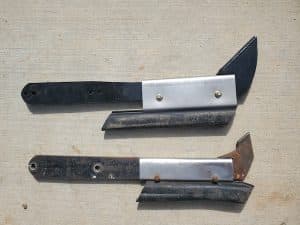Why wait to seed canola?
Early seeding can be somewhat less risky than late seeding, but what is “early” for canola in Western Canada? The broad definition is late April to mid May – with late April appropriate for the southwest Prairies and mid-May about right for northern Alberta. Seeding early helps the crop avoid the hottest summer days at flowering, but seeding too early means high frost risk. Early emergence and slow growth also raise the risk of devastation from flea beetles because plants are still vulnerable when seed treatment starts to diminish. Early crops are also a magnet for hungry flea beetle adults emerging from winter hibernation. John Gavloski, entomologist for Manitoba Agriculture, says canola will have lower risk of flea beetle damage if it grows quickly – going from seeding to four-leaf stage in three to four weeks. Quicker growth often comes with seeding into warmer soils.
Replace those worn openers
We have a check list to make sure the drill is ready to seed canola in a few weeks. Top of the list this year is to make sure the drill is ship shape to place seed into the soil at a consistent depth and to maintain good separation between seed and fertilizer. Seed should be by itself, except for a bit of starter phosphate (say 20 lb./ac.). The rest of the fertilizer should be outside the seed row. In a one-pass system, that means a side band or mid-row band. To maintain seed-fertilizer separation with side-band openers, you really want to make sure those openers are sharp, properly positioned and consistent across the width of the drill. Other pre-season drill prep steps include checking hoses and tires, leveling and more. These prep steps are especially important with a new or new-to-you drill. Listen to a PODCAST on this topic. Seeding canola in dry conditions.

Pre-seed banding leaves dry seed bed
Growers who apply a lot of nitrogen through a pre-seed banding operation might want to look at a plan B with current dry soil conditions – because that first pass could leave the soil bone dry for seeding. A broadcast application before or after seeding is not 4R on its own, but it could achieve the 4R checkmark with an enhanced-efficiency product to protect your nitrogen investment and reduce losses. Product options.
While waiting to seed, there may be enough time for soil tests to confirm the reserve nutrient situation in some fields. The right rate for one field may not be the right rate for all fields. Soil tests will help tailor rates for each field.
Spray weeds two weeks before seeding. Really?!
Winter annuals and perennials are waking up and will soon take up valuable moisture and nutrients. On a nice warm afternoon when the sun is shining, it would probably pay to give them a pre-seed burnoff – even if seeding won’t happen for a couple of weeks. University of Saskatchewan research (described here) found that even if the crop is not seeded until later, an early burnoff is still preferred. Just make sure to use a tank mix to improve glyphosate efficacy. Tips on timing and tank mixing.